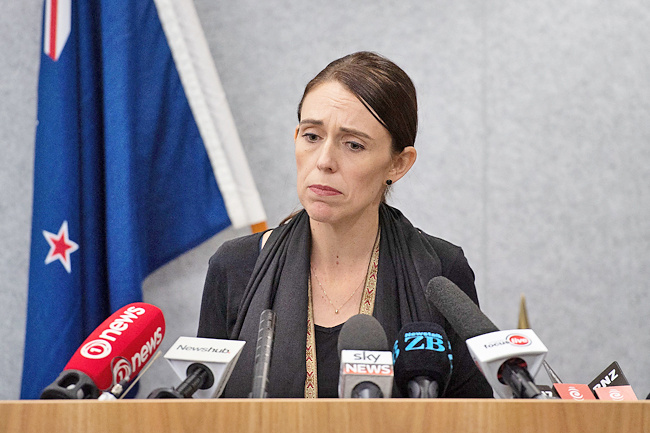Kelyn Soong
THE WASHINGTON POST – When Jacinda Ardern announced her decision to resign as New Zealand’s Prime Minister, she didn’t cite burnout as the reason. But she described it.
“I know what this job takes, and I know that I no longer have enough in the tank to do it justice,” she said. “It is that simple.”
The World Health Organization (WHO) in 2019 acknowledged burnout as an “occupational phenomenon”, but job or work burnout can still take a significant toll on your mental and physical health, and is closely linked with depression and anxiety.
Burnout is common among healthcare workers, medical students and caregivers. But it can also be experienced in other professions.
This week, Fall Out Boy guitarist Joe Trohman announced he is “stepping away” from the band for the sake of his mental health. And tennis star Naomi Osaka was at the top of her game in 2021 when she announced she needed a break from the sport.
Here’s what mental health experts have to say about burnout, how to identify it and how to cope.


WHAT IS BURNOUT?
Burnout “can mean many different things to many different people”, said Director of Research and Innovation at Brown University’s Mindfulness Center and Chief medical officer of Sharecare, a digital health company Jud Brewer. “Burnout applies to anybody. So, really, it’s about when somebody is just functionally not up to the task anymore.”
According to the Maslach Burnout Inventory, a widely accepted diagnostic tool, burnout occurs when three factors are present at the same time: emotional exhaustion, depersonalisation and a diminished sense of personal accomplishment.
Burnout is often described as feeling emotionally depleted by work and just not caring as much, feeling cynical or seeming callous, or distancing oneself from situations.
“So for example, physicians, they get a reputation for not being the most warm people,” said Brewer. “Some are great, and often when physicians are burnt out, they’re just kind of distancing themselves from their patients, and that kind of gets read as callousness.”
WHAT DOES BURNOUT FEEL LIKE?
Professor in the Department of Psychiatry and Behavioural Sciences at University of California, San Francisco Elissa Epel said Ardern’s resignation speech offered a vivid description of burnout.
“I love her analogy to, ‘My tank is empty’. Burnout feels like your tank is beyond empty,” said Epel, the author of The Stress Prescription: Seven Days to More Joy and Ease. “You are actually suffering, because you’ve lost your energy. You’ve lost it physically. And you’ve also lost some of the motivation that has helped you fuel the tank for years or decades. So it’s very demoralising to feel burnout.”
Burnout isn’t defined by physical exhaustion or just being tired from long hours of work. But people with burnout often feel exhausted, Epel said.
“Feeling emotionally exhausted means you’re not feeling yourself,” she added. “You’re not in touch with your emotions anymore. And in fact, your emotions have become restricted and you feel numb, when you used to care so much.”
Burnout can lead to feeling overwhelmed. “We’re no longer able to feel specific emotions, and our body’s responding to that overwhelmed message that the mind is sending by keeping the stress response system on high alert, even when we sleep,” Epel said.
HOW DO I KNOW IF I AM REALLY BURNED OUT OR JUST WORKING HARD?
One way to know if you have burned out is simply to think about your job and gauge your reaction, Brewer said.
“What happens?” he said. A person can be less than enthusiastic about work and not be burned out. But if the reaction is “Oh, goodness. I dread this”, and a person is trying to avoid work, then those can be signs of burnout.
WHAT’S THE DIFFERENCE BETWEEN BURNOUT, ANXIETY AND DEPRESSION?
While burnout is closely linked with anxiety and depression, there are distinct differences. Some people even refer to burnout as “work depression”, said Epel.
Some of the physical symptoms are the same, such as feeling fatigued, depleted of energy and irritable, sad or anxious.
“One might also develop a sense of hopelessness about their role and their efficacy and feel like things won’t ever change at work,” Epel said. “And so that’s a parallel to depressive thinking, where we feel hopelessness, and we don’t see any bright light or end to our misery in the future.”
Depression often centres on the self and feeling worthless or being self-critical, Epel said.
Burnout is centred on the “untenable chronic stress of work demands, whether it’s unpaid work at home, such as being a caregiver, or demands from your day job”, she said.
Epel said studies of surgical residents have identified high levels of suicidality and depression as a result of burnout.
“So chronic stress is, alone, harmful to our bodies and our emotional well-being,” she said.
“Burnout is a specific response to overwhelming chronic stress, typically from work. And depression is a more severe emotional response to chronic stress and burnout.”
WHAT CAN I DO TO COPE WITH BURNOUT? IS QUITTING OR RESIGNING THE ONLY OPTION?
The reasons behind burnout can be different for different people, Brewer said. As a result, it’s important for people to try to understand the root cause.
Lifestyle factors, such as a poor diet, lack of sleep and no time to exercise, can play a role in burnout. And mental health issues, such as anxiety and depression, should be considered.
Things over which people have less control, like long work hours, impossible deadlines and little time to recover and recuperate from work, can play a role in burnout, he said.
“It’s really looking to see, what is it that is leading to that burnout, and then getting at those root causes and seeing what someone can do,” Brewer said.
Focussing on healthy habits and treating someone for anxiety, for instance, could help.
“There are individual elements related to burnout and there are institutional elements,” he said.
While addressing individual issues can help, the overall problem won’t be solved if changes aren’t possible in the workplace.
“The most dramatic way to address burnout is to leave the workplace,” Epel said. “And it is unfortunate that people are often left with that as the only option, because as an individual, they cannot change the system and the structures in place that are creating a burnout culture.”
INDIVIDUAL MANAGERS, HOWEVER, CAN MAKE A DIFFERENCE
“I do think that managers at every level can change the environment to mitigate the burnout culture,” she said. “And part of it is managing daily schedules to make them flexible, to provide required breaks, to encourage a culture of well-being by modelling their own vulnerability to stress.”





